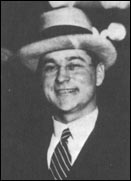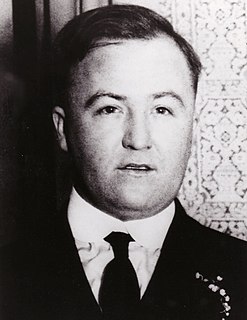
Alphonse Gabriel Capone, sometimes known by the nickname "Scarface", was an American gangster and businessman who attained notoriety during the Prohibition era as the co-founder and boss of the Chicago Outfit. His seven-year reign as a crime boss ended when he went to prison at the age of 33.

George Clarence "Bugs" Moran was an American Chicago Prohibition-era gangster. He was incarcerated three times before his 21st birthday. Seven members of his gang were gunned down and killed in a warehouse in the Saint Valentine's Day Massacre of February 14, 1929, supposedly on the orders of his rival Al Capone.

John Donato Torrio was an Italian born-American mobster who helped build the Chicago Outfit in the 1920s later inherited by his protégé Al Capone. Torrio proposed a National Crime Syndicate in the 1930s and later became an adviser to Lucky Luciano and his Luciano crime family.

Earl J. "Hymie" Weiss, was a Polish-American mob boss who became a leader of the Prohibition-era North Side Gang and a bitter rival of Al Capone. He was known as "the only man Al Capone feared".

Vincenzo Colosimo, known as James "Big Jim" Colosimo or as "Diamond Jim", was an Italian-American Mafia crime boss who emigrated from Calabria, Italy, in 1895 and built a criminal empire in Chicago based on prostitution, gambling and racketeering. He gained power through petty crime and by heading a chain of brothels. From about 1902 until his death in 1920, he led a gang that became known after his death as the Chicago Outfit. Colosimo was assassinated on May 11, 1920, and no one was ever charged with his murder. Johnny Torrio, an enforcer whom Colosimo imported in 1909 from New York, seized control of Colosimo's businesses after his death. Al Capone, a close associate of Torrio, has been accused of involvement in Colosimo's murder, but was not yet in Chicago at the time.

Louis "Two Gun" Alterie, born Leland A. Varain, and aka "Diamond Jack Alterie", was a Californian who became a notorious hitman for the Chicago North Side Gang during the early years of Prohibition.

The Chicago Outfit is an Italian-American organized crime syndicate or crime family based in Chicago, Illinois that originated in the city's South Side in the early 1910s. It is part of the larger Italian-American Mafia.

Michele "Mike" Merlo was a Chicago political figure and "fixer" associated in his later years with the Torrio-Capone organization. As head of the Unione Siciliana fraternal group, Merlo wielded considerable influence both in Chicago's Democratic Party politics and also within Chicago's criminal underworld during the early years of Prohibition. Although Merlo was able to maintain peace among the city's numerous bootlegging gangs, his death marked the beginning of Chicago's bootleg wars that plagued the city for the rest of the decade.
Ragen's Colts was a chiefly Irish street gang which dominated the Chicago underworld during the early twentieth century. By the late 1920s and early 1930s, the gang became part of the Chicago Outfit under Al Capone.
Chicago, Illinois, has a long history of organized crime and was famously home to the American mafia figure Al Capone. This article contains a list of major events related to organized crime.
The Genna crime family, was a crime family that operated in Prohibition-era Chicago. From 1921 to 1925, the family was headed by the six Genna brothers, known as the Terrible Gennas. The brothers were Sicilians from the town of Marsala and operated from Chicago's Little Italy and maintained control over the Unione Siciliana. They were allies with fellow Italian gang the Chicago Outfit. After a bloody war led to their demise in the 1920s, the gang was eventually absorbed by the Chicago Outfit.
The North Side Gang, also known as the North Side Mob, was an Irish-Polish-American criminal organization within Chicago during the Prohibition era from the early 1920s to the mid-1930s. It was the principal rival of the South Side Gang, also known as the Chicago Outfit, the crime syndicate of Italian-Americans Johnny Torrio and Al Capone.
The Atlantic City Conference held between 13–16 May 1929 was a historic summit of leaders of organized crime in the United States. It is considered by most crime historians to be the earliest organized crime summit held in the US. The conference had a major impact on the future direction of the criminal underworld and it held more importance and significance than the Havana Conference of 1946 and the Apalachin meeting of 1957. It also represented the first concrete move toward a National Crime Syndicate.
Joseph Esposito was an American politician best known for his involvement in bootlegging, extortion, prostitution and labor racketeering in Chicago, Illinois during the Prohibition era.
Danny Stanton was a Chicago mobster and labor union racketeer for the Chicago Outfit during Prohibition. An early leader of the Sheldon Gang, he later headed members of the Ragen's Colts on behalf of Al Capone in support of the Druggan-Lake Gang during the bootleg wars of the mid-1920s.

Charles Dean O'Banion was an American mobster who was the main rival of Johnny Torrio and Al Capone during the brutal Chicago bootlegging wars of the 1920s. The newspapers of his day made him better known as Dion O'Banion, although he never went by that first name. He led the North Side Gang until 1924, when he was shot and killed, reportedly by Frankie Yale, John Scalise and Albert Anselmi.
Vincenzo "James" Genna was an Italian-born mobster in Chicago. He headed the Genna crime family with his brothers. Genna and his brothers waged war against the North Side Gang before half of the brothers were killed and Genna fled.








